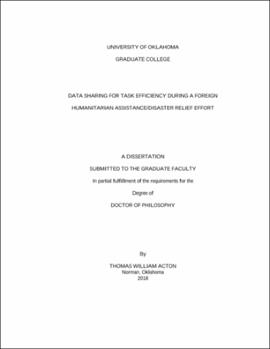| dc.contributor.advisor | Franklin, Aimee | |
| dc.contributor.author | Acton, Thomas William | |
| dc.date.accessioned | 2018-12-18T14:51:31Z | |
| dc.date.available | 2018-12-18T14:51:31Z | |
| dc.date.issued | 2018-12-14 | |
| dc.identifier.uri | https://hdl.handle.net/11244/316808 | |
| dc.description.abstract | This paper adapts Zigurs & Buckland’s (1998) Task Technology Fit theoretical framework for application to a virtual organization that exists for episodically during foreign humanitarian assistance/disaster relief efforts. Using the 2004 Indian Ocean tsunami, the 2010 Haiti earthquake, and more than 1000 lessons learned cases from the federal government, I examine how task activities, process support level, military command level and partner types influence the technology platform that is used for structured and unstructured data sharing in real time. The predicted fit between task and technology is supported; however, addition of consideration of the virtual nature of the internal and external partnerships that are required for foreign disaster relief efforts improves the explanatory model. Recommendations for theory changes and the practical implications of this research for future foreign disaster relief efforts are explored. | en_US |
| dc.subject | information sharing | en_US |
| dc.subject | humanitarian assistance | en_US |
| dc.subject | organizational leadership | en_US |
| dc.subject | information technology | en_US |
| dc.title | DATA SHARING FOR TASK EFFICIENCY DURING A FOREIGN HUMANITARIAN ASSISTANCE/DISASTER RELIEF EFFORT | en_US |
| dc.contributor.committeeMember | Gabert, Trent | |
| dc.contributor.committeeMember | Deacon, Zermarie | |
| dc.contributor.committeeMember | Kim, Young | |
| dc.contributor.committeeMember | Mitra, Aparna | |
| dc.date.manuscript | 2018-12-14 | |
| dc.thesis.degree | Ph.D. | en_US |
| ou.group | Graduate College | en_US |
